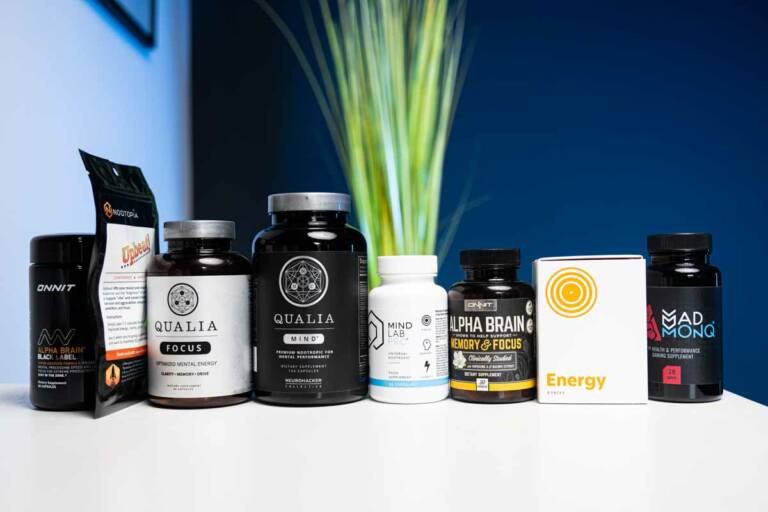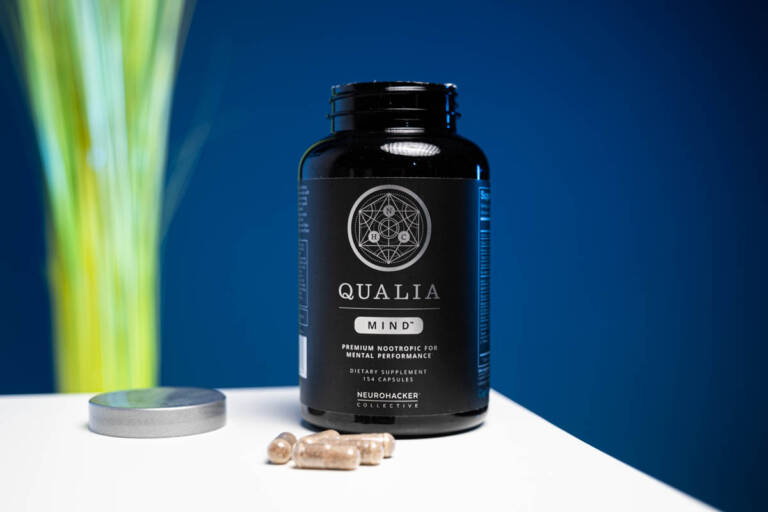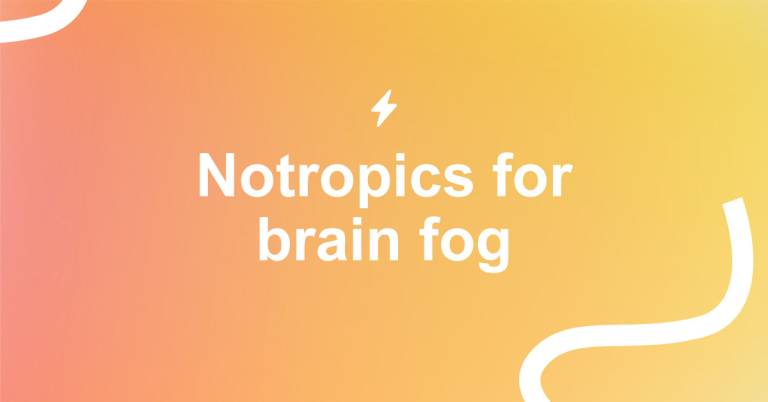Eye Vitamins
Do you know which are the best eye vitamins? And why should you even care about them? Let’s find out.
Our use of the phrase “common sense” is interesting. More often than not, when we refer to “common sense” we refer to “good judgment.” Someone who behaves with common sense makes decisions prudently, guided by the power of reasoning.
Really, good decision-making isn’t all that common. In fact, the more common sense seems to be less a matter of intellect and more a matter of sensual perceptual. The five senses comprise a truly common sense: touch, taste, hearing, smell, and sight.
These senses are so common that we actually take them for granted while they’re working. However, when our senses falter, when they begin to deteriorate with age or injury, we take notice. We visit physicians and specialists to restore our senses. And we “correct” our deteriorated senses with medications and devices: hearing aids correct hearing, glasses correct seeing, and so on.
Of course, some of this is merely genetic. Some people lose their eyesight faster than others, whereas others maintain 20:20 vision for the majority of their lives. That’s life, which forces us to play the cards we’ve been dealt.
Having said that, there are ways to improve and protect our senses, to ensure that our sensual points of engagement with the world remain in working order for as long as possible.
In this article, we are focusing solely on the sense of sight, which channels through one of our favorite balls attached to the human body: the eyeball.
Taking care of your eyesight seems like common sense, but, again, common sense isn’t exactly all that common, all things considered. And so by diving into the anatomy of the eye, into the ways in which we hurt and help our eyesight, as well as into the best eye vitamins for promoting visual health and performance, we hope to reveal why eye care is important, even to those of us with seemingly, permanently perfect 20:20 vision.
The Anatomy of the Eye
Before tackling the question of vision, let’s first address how the eye works.
Roughly speaking, the eye receives light, transferring the light rays from the cornea (the eye’s surface) to the retina (the nerve layer lining the back of the eye), where retinal cells transfer light to electrochemical impulses to be transferred to the brain via the optic nerve.
Between the cornea and the retina, the eye’s lens helps focus the light rays while the iris and pupil change sizes to determine how much light passes through the eye. In the darkness, the pupil enlarges to allow for more light to pass through. To handle bright environments, the pupil shrinks, decreasing the passage of light to the retina, so as not to overwhelm vision with too much light.
Here’s a useful illustration on the anatomy of the eye:
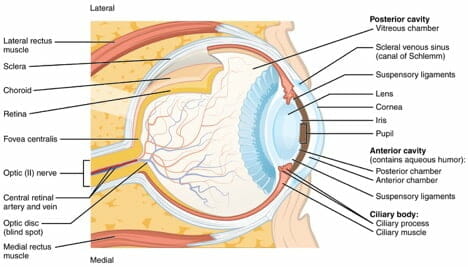
Image via OpenStax College [CC BY 3.0]
Missing in the illustration is the macula, a special light-sensitive area in the retina that allows us to distinguish fine details of objects and sightlines in the center of our visual field. As we age, macular deterioration becomes an increasingly common condition, resulting in increasing difficulty in discerning visual details.
For the most part, the way our eyes bend, or refract, light primarily determines the clarity of our vision. Depending on the different surfaces and substances they encounter, light rays can be deflected, reflected, refracted, or absorbed.
Look at your hand. Technically, you’re not literally seeing your hand but rather the light reflected off your hand. In turn, your eye’s cornea and the lens refract, like water, the hand-reflected light, routing the light towards the retina, where light-sensitive cells (photoreceptors) absorb the light and submit it to the brain, which interprets the light as being reflected off your hand.
This, in a nutshell, is how vision works. Or at least how vision should work. Any errors in refraction or absorption — or any number of factors between the cornea and the brain – may impair eyesight, leading to a loss in visual performance.
Not only is impaired vision a substantial lifestyle detriment but it also significantly impacts one’s professional opportunities, especially for professions involving competitive athleticism and fast reaction times.
Symptoms and Causes of Vision Loss
Initially, the blurry vision is subtle. For many, the gradual loss in vision goes unnoticed until you realize that, say, sitting in the back of the classroom reliably renders the teacher’s writings illegible. You have to squint to see the hands on the clock on the other side of the room, and you start to recognize the anxiety you feel in public spaces where you’re unable to read people’s facial expressions.
Blurry vision, caused by refractive errors (i.e., errors in how the eye bends light), is the most common reason for visits to the eye doctor. Young and old may experience this sort of blurry vision to varying degrees. The three eye features that affect light refraction:
- Eye Length – long eyes focus light too early, leading to nearsightedness; short eyes fail to sufficiently focus light, leading to farsightedness.
- Cornea Curvature – an irregularly shaped cornea, or one that’s not totally spherical, irregularly focuses light, creating a condition known as astigmatism.
- Lens Curvature – relative to eye length, a steep curvature promotes nearsightedness, whereas a flat curvature lends to farsightedness.
It’s perhaps worth explaining here that nearsightedness, or myopia, allows one to see close objects clearly but not objects in a distance. Farsightedness, or hyperopia, is the opposite condition: nearby objects are blurry, distant objects are clear. These sorts of eye problems tend to be genetically-linked more often than not.
Mostly common to older people, other eye-related conditions of vision loss include the clouding of the eye lens (cataracts), damage to the optic nerve (typical of glaucoma), and damage to the retina (typical of macular degeneration and diabetic retinopathy). Migraines may result in temporary vision loss. Likewise, blockages in the retinal artery decrease blood circulation to the eye, resulting in visual impairment and eye fatigue issues. Many age-related vision issues have mixed causes, both genetic and environmental.
Of course, your mileage may vary for many of these conditions. Some of us even experience more unique visual conditions, such as color blindness, or strange perceptual phenomena, such as synesthesia. And the degrees to which vision loss can be prevented or corrected vary from person to person, condition to condition.
Common Myths Associated with Vision Loss
Often we misattribute activities that cause eye strain to vision loss. Intensely staring at pixels on a screen while Photoshopping an image, sitting too close to the television, reading in the dark – these activities might strain the eyes, forcing them to focus for a duration and with an intensity that’s visually taxing, but there isn’t any significant evidence that they chronically impair vision.
Even so, eye fatigue does temporarily affect visual performance, resulting in greater difficulty in maintaining cognitive composure and completing a task.
On the flip side, some myths are true. Yes, staring into the sun may permanently damage the retina. Avid surfers who spend a lot of time in sun-refracted waters often develop eye issues due to excessive solar exposure. Also, yes, artificial sweeteners seem to affect visual color and light sensitivity.
Can Vision Loss be Prevented?
As suggested earlier, your mileage may vary here. Common issues related to blurry vision, the type that’d lead us to prescribed glasses and corrective contact lenses, tend to be genetic. And we can’t necessarily prevent our genetic makeup. (Not yet, at least, which is a creepy thought.)
But, certainly, proper eye care practices may go a long way in preserving your vision to its relative maximum efficiency.
Malnourishment is a common factor in vision loss. Nutrient-deficient diets and overconsumption of junk foods deprive the eyes – not to mention the rest of the body – of essential micronutrients that support ocular health and maintenance while also comprising the colored pigments of the eye.
In fact, many of the antioxidant eye vitamins found in vision supplements (e.g., lutein, zeaxanthin) are naturally, highly concentrated in the eye, protecting the retina against harmful UV light rays on the light spectrum. While it’d perhaps be an exaggeration to claim that these eye vitamins outright prevent vision loss, they do possess a lot of promise in the field of ocular health.
Seeing that these antioxidants help filter harmful UV light rays, it’s smart to also filter harmful UV light in other ways, such as wearing UV protection sunglasses outside.
On that note, while TVs, computer monitors, and smartphone screens don’t emit a substantial amount of UV light, they do emit blue light, which increases oxidative stress in the eye. It might be a false myth that sitting too close to the TV deteriorates vision; however, prolonged exposure to electronic screens, in general, doesn’t seem too great on the eyes.
Whether for ocular health or general productivity, reducing screen-time may help.
The Age-Related Eye Disease (ARED) Studies
In terms of clinical research, two studies stand out in noting the remedial benefits (or lack thereof) of certain eye vitamin supplements. Respectively called the Age-Related Eye Disease Study (AREDS) and Age-Related Eye Disease Study 2 (AREDS2), the studies investigated the effects of daily multivitamin use on the progression of age-related macular degeneration (AMD) and cataracts among thousands of participants across a span of at least five years.
In the first ARED study – the multivitamin ingredients in question included beta-carotene (15mg), vitamin C (250mg), vitamin E (400 IU), zinc (80mg), and copper (2mg). Over 3,500 people, aged 55 to 80, participated in the study, many of whom already had early AMD. The researchers found that the antioxidant multivitamin reduced the risk of AMD progression among people at high risk of vision loss due to AMD by 25%; although cataract progression seemed unaffected.
The second ARED study – the modified multivitamin supplement for AREDS2 included lutein (10mg), zeaxanthin (2mg), omega-3 fatty acids (350mg DHA, 650mg EPA), and zinc (25mg). The additions of lutein and zeaxanthin were justified by other studies that found a lower risk of developing advanced AMD associated with lutein/zeaxanthin + omega-3 intake.
Compared to the original ARED multivitamin, this modified stack demonstrated an even lower risk of developing advanced AMD (a relative 18% lower). This improvement may be attributed to the addition of lutein + zeaxanthin.
It’s worth noting that beta-carotene was removed from the AREDS2 supplement due to the vitamin’s associated health risks when consumed by smokers and previous smokers.
What is a Healthy Diet for Better Vision?
Of the participants in AREDS2, those who started the study with low dietary intake of lutein and zeaxanthin found themselves 25% less likely to develop advanced AMD when taking the lutein-/zeaxanthin-modified supplement. With that in mind, consuming foods rich in dietary lutein and zeaxanthin may help improve vision health; such leafy green foods as kale, spinach, Swiss chard, mustard greens, turnip greens, collard greens, and more.
Egg yolk also seems to possess a significant, bio-available amount of lutein and zeaxanthin.
In general, a healthy diet that emphasizes fruits and vegetables, lean meats, fish, eggs, and nuts seems to promote good vision.
Do carrots also improve eyesight? Yes, insomuch that the beta-carotene (vitamin A) that gives carrots their orange color helps with the eyes’ ability to adjust to the darkness – i.e., night vision. Other orange-colored fruits, such as sweet potatoes, cantaloupe, mangos, and apricots, may also help on this front.
Our recommendation is to research which foods are highest in the minerals, vitamins, and oils used in the ARED studies to determine a healthy vision diet that works for you.
Is a Vision Supplement Necessary?
If the minerals, vitamins, and oils can be consumed naturally through the diet, is a vision supplement even necessary? Perhaps not if you can truly achieve sufficient levels of these nutrients.
And, really, it’s not a bad dietary goal to shoot for, given how many other healthy nutrients are in these foods that benefit the brain and body across the board.
But given the high expense of eating solely nutrient-rich foods, as well as the loss of nutrients due to modern food processing techniques, it can be rather difficult to maintain a healthy enough diet to boost visual performance, let alone maintain proper eye care.
In this sense, multivitamin supplements supplement an earnest, healthy diet.
Even so, this is a common question in the multivitamin conversation at large: do we need vitamin and mineral supplements at all?
Again, your mileage may vary. For example, a high-intensity training athlete or bodybuilder has higher nutrient demands than the chair-ridden academic.
For the former, the *need* for a multivitamin supplement is theoretically greater than that of the latter. But, then again, the chair-ridden academic may enjoy a vision-oriented multivitamin for the relief of eye strain and protection against blue light exposure.
At the least, where vision is concerned, the AREDS should serve as a guideline on which eye vitamins are important. If you can find a supplement that supplies these vitamins in easy-to-absorb forms, without any additional junk additives, the investment is likely worth it.
Who Takes Vision Supplements?
According to the National Eye Institute, who performed the AREDS, the people who should consider taking an antioxidant multivitamin similar to those used in the studies are “people at high risk for developing advanced AMD”; these people being defined as having either (verbatim):
- Intermediate AMD in one or both eyes. Intermediate AMD can be detected by an eye care professional, but usually involves little or no vision loss.
- Advanced AMD in one eye, but not the other eye. Advanced AMD involves either a breakdown of cells in the retina (called geographic atrophy or dry AMD) or the growth of abnormal blood vessels under the retina (called neovascular or wet AMD). Either of these forms of advanced AMD can cause vision loss.
Naturally, vision supplements are a hot topic where age-related vision loss is concerned. As such, many vision supplements seem tailored to an elderly demographic.
Yet, many vision supplements also seem geared to certain younger demographics, namely those who spend an exceptional amount of time working in front of a computer screen, as well as video gamers. In fact, professional video gamers, such as eSport athletes, are seeing an increase in vision supplements with “gamer” themes attached to them. This seems to parallel rise in interest in blue light-filtering glasses and other eye-protective devices.
Much of this makes sense in both a health and a performance context. As more and more of us are spending more and more time in front of screens, we’re experiencing a net increase in eye fatigue, visual strain, sensory overload, etc. And with so much money on the line for competitive gamers, maintaining quick twitch reaction speeds and sustaining a sharp visual focus to discern the fine details in the pixels are key to success.
Our point is that it seems soon enough that vision supplements will be a much more mainstream genre of supplements.
Are There Different “Types” of Vision Supplements?
Unlike, say, sleep aid supplements or energy boosters, which respectively parallel such comparable pharmaceutical options as heavy “sleeping pill” sedatives (e.g., Ambien) and powerful “smart drug” stimulants (e.g., Adderall), natural vision supplements don’t necessarily parallel any well-known, prescription-only class of vision boosters.
Certainly, some nootropics, such as coluracetam, may possess vision enhancing properties, anecdotally speaking. But as far as “types” of vision supplements go, they tend to be almost strictly on the scale of natural multivitamin supplements.
Even so, a difference in formula design and ingredient quality may significantly distinguish one vision supplement from another. Because vitamins are so easily denatured via shoddy manufacturing processes, it’s important to find an eye vitamin supplement that:
- Abides by clean manufacturing processes.
- Supplies bio-active, preferably nature-identical ingredient forms.
- Avoids unnecessary “gimmick” ingredients and cheap additives.
A “gamer” themed vision supplement might supply stimulants and other dopaminergic ingredients for that additional mental boost. This is fine if that’s what you’re looking for. But for the most part, we think it best to stick with a vision supplement with its eye solely on the prize: better, healthier vision.
The Performance Enhancement Benefits of Vision Supplements
Covering the anatomy of the eye establishes the biological underpinnings of vision: where and how vision occurs, as well as which eye regions certain vitamins and nutrients target to improve vision. But once improved, what (other than improved health) are the tangible performance benefits of a better, healthier vision?
Roughly speaking, the performance enhancement benefits of enhanced vision include:
- Faster reaction time
- Shorter glare recovery time
- Increased hand-eye coordination
- Sharper attention to fine details
- Improved night vision
- Enhanced color recognition
- Reduced eye strain and fatigue
- Quicker cognitive processes
This last benefit is worth special consideration.
To think fast requires one to sensually perceive and cognitive interpret an event quickly. If the eyes are slow to discern details, to accordingly adjust to a shift in light or color, the mind is slow to react. And this framework only observes the relationship between visual speed and cognitive speed. Even where speed isn’t a factor, where you’re working alone with enough time to calculate and consider your next move, and impaired visual acuity may completely upset your cognitive composure.
It’s a strange delicate balance. And, again, it’s one we take for granted, up until the point we notice visual deterioration. But it’s a balance worth maintaining, not only for your visual health but your mental health as well.
Best Eye Vitamins
Okay, so we know vision supplements may help with eye care, and we know, roughly, who takes vision supplements. The big question then: what are the best vision supplements that are safe and effective?
While it is possible to mix-and-match standalone eye vitamins to concoct your own vision aid formula, we’ve found one supplement that serves as a great model for which eye vitamins to take to improve eye health.
Performance Lab Vision, a simple, natural eye supplement, supplies an impressive mix of antioxidant ingredients, all of which contribute to eye health and possibly more.
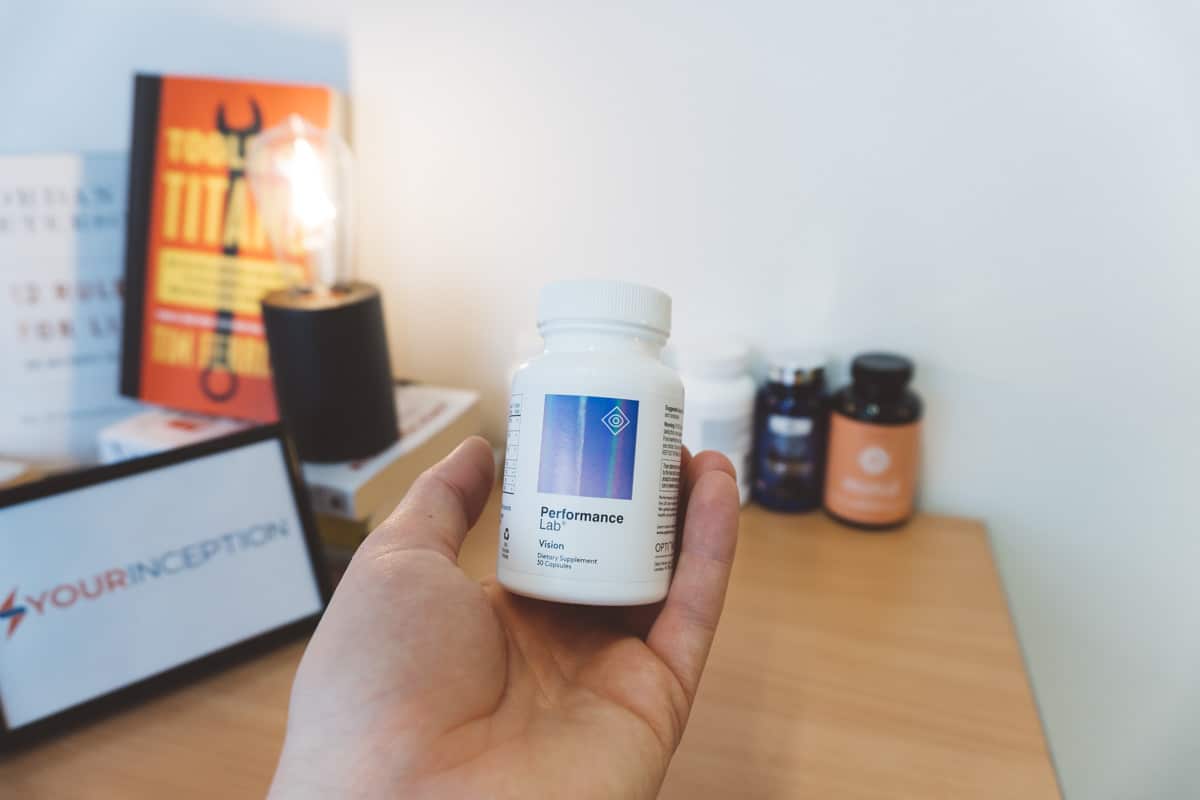
Other eye vitamins, many of which seem tailored to gamers and the elderly, do supply good ingredients, but often in weak ingredient forms, at unknown dosages, and alongside a bunch of junk additives and filler. Performance Lab Vision removes the unnecessary additives, stacking only the following eye vitamins:
Lutein + Zeaxanthin
These two potent carotenoid antioxidants often referred to as “vision vitamins,” are highly concentrated in the macula, the retinal eye region responsible for sharp, clear vision. Essentially, lutein and zeaxanthin protect the macula against harmful blue light exposure (the type of high-energy radiation projected from the monitor or screen you’re currently staring at). These antioxidants filter blue light before damaging the macula while also limiting oxidative stress damages associated with photon conversions by retinal photoreceptors.
For age-related macular degeneration (AMD), promising research has found lutein and zeaxanthin supplementation significantly beneficial in improving visual performance under AMD conditions. Even among visually healthy users, supplementing lutein and zeaxanthin seems to enhance high-resolution and low-light vision.
Astaxanthin
Found in algae and algae-consuming animals, astaxanthin is a pinkish, reddish xanthophyll antioxidant shown to improve blood circulation to the retina. By increasing the delivery of oxygen and nutrients to the eye, astaxanthin’s bio-activities seem particularly useful in combatting eye strain and fatigue. To workers and students who stare at computer screens all day, astaxanthin is a vision enhancer of special value. The reduction in eye strain and ocular inflammation allows the eyes to maintain focus and vitality throughout the day.
Similar to lutein and zeaxanthin, astaxanthin also seems to reduce free radical levels associated with UV light exposure in the retina. There are also potential nootropic advantages to astaxanthin’s antioxidant status, given the compound’s ability to cross the blood-brain barrier.
European Blackcurrant Extract
Rationed to World War II British fighter pilots, black currents are a super berry grown in the United Kingdom that supply a rich complex of anthocyanin antioxidants; one of which, cyanidin-3-glucoside (C3G), helps the retina regenerate rhodopsin. Rhodopsin helps with night vision, as well as visual speed and acuity, hence the prescription of black currants to British pilots.
For recreational use, the performance-enhancing aspects of blackcurrant extract help bolster eyesight adaptation to the dark and retina-to-brain signaling for improved reaction time. This is a great vision enhancer for athletes and gamers.
European Bilberry Extract
Often stacked with blackcurrant, bilberries also supply a rich complex of dark-purple pigmented anthocyanosides, including C3G for additional night vision support. Additionally, bilberry extract also improves eye capillary flexibility, in turn improving ocular blood circulation throughout the retina for improved visual performance, vitality, and fatigue recovery.
Saffron Extract
Safranal and crocin, saffron’s two most bioactive constituents for eye health, are yellow plant pigments that protect the macula and sharpen vision performance by supporting retinal flicker sensitivity, allowing for better detection of fine movements, and protecting against the damaging glare of blue light exposure.
As a plant product, saffron is best known for its vivid crimson color and spicy flavoring, often used as both a coloring agent and spicy seasoning. But to achieve its vision-enhancing effects, a saffron extract is necessary to isolate its eye-healthy compounds to a higher, active concentration.
Micronutrients for Healthier Eyes
The Performance Lab Vision formula supplies a simple mix of antioxidants that are great for eye health and visual performance. But for comprehensive eye care, and an all-around solid nutritional base, stacking a vision supplement with a multivitamin supplement may help cover other vitamin and mineral deficiencies. And Performance Lab Whole-Food Multi works particularly well with Performance Lab’s vision supplement. The supplement splits into two separate formulas: one “For Men” and one “For Women.”
Again, while it’s true that you may achieve healthy micronutrient levels via a healthy, complete diet, modern food processing techniques make it difficult (and expensive) to do so. Multivitamins help pick up the modern diet’s slack. Especially for athletes and bodybuilders who possess higher nutritional demands to maintain their exercise performance and muscle mass growth.
This stack works exceptionally well at improving the user’s micronutrient levels, thanks to the formula’s unique, patented, nature-identical BioGenesis™ fermentation process. Rather than use cheap, synthetic ingredient forms, Performance Lab Whole-Food Multi opts for a more natural formula design, one that’s more conducive to micronutrient digestion and absorption.
All in all, it’s not a bad idea to pick up a multivitamin stack, at least to establish a firm enough micronutrient base upon which to maintain healthy cognitive and physical growth, immune function, and, yes, visual acuity.
Verdict
Your Inception recommends supplementing eye vitamins & supplements.
Ideally, if everyone could consume all of the antioxidants and micronutrients essential to healthy vision through a well-balanced diet, this would likely solve many other health issues that ail us. While seeking a healthy diet and lifestyle remains the primary recommended form of eye care, the well-documented benefits of eye vitamin supplements are undeniable.
Even those with generally healthy eyes see (literally) improvements in their vision following a few weeks of eye vitamin supplementation. It’s an incredibly important, overlooked aspect of health and performance; perhaps overlooked because we tend to overlook our means of looking altogether. Again, we take vision for granted.
We like the Performance Lab line of supplements for their consistently high-quality ingredients and mix-and-match customizability.
In an otherwise gimmicky supplement genre, Performance Lab Vision’s simple, straightforward formula design definitely stands out; and, thanks to the lack of fillers and bogus ad jargon, it’s easy to see how each ingredient contributes to better vision and eye health.
Frequently Asked Questions
How long until eye vitamin supplements work?
Some benefits may be noticed as early as two weeks; however, the effects cumulate over time, gradually improving eye health and function in a long-term commitment towards better visual performance and protect eye health.
Do I need to cycle eye vitamin supplements?
For the eye vitamins mentioned, the answer is no. These antioxidants actually seem to work best with long-term daily use. Thanks to their formula’s preservative-free, GMO-free, vegan-friendly design, they’re generally well-tolerated and safe to use for the long run.
Are vision supplements legal to use for competitive purposes?
While vision supplements may enhance competitive performance, they do not qualify as performance enhancement drugs (PEDs) in any legal sense. Natural eye vitamin supplements are a 100% legal method of optimizing eyesight for boosted athletic and gaming performance.
